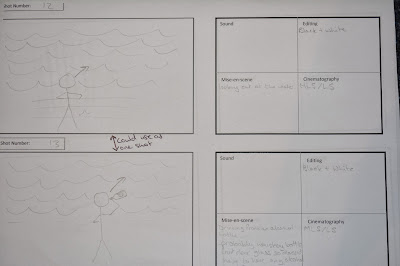For my genre, (alternative rock/ folk rock) album covers don't usually show the artist but usually show something relating to the song or album name. For my digipak cover, I will follow this convention and not use an image of my artist however I will take some pictures of my artist to use either on other sections of the digipak or on a promotional poster. Because my chosen song is about how the artist is a pessimist I will use an image relating to this such as a half empty glass. However a lot of artists of these genres use images of forests and other nature-esque images (as shown in the Kodaline EP at the top) so I might try something like that. Most of the albums are packaged in a card sleeve rather than a traditional plastic CD box. This is primarily to save money so that the artist can afford to sell the album at a much lower price and still make a profit but it is also to make the album sleeve easily recyclable.
Wednesday, 18 December 2013
Album Cover research
For my genre, (alternative rock/ folk rock) album covers don't usually show the artist but usually show something relating to the song or album name. For my digipak cover, I will follow this convention and not use an image of my artist however I will take some pictures of my artist to use either on other sections of the digipak or on a promotional poster. Because my chosen song is about how the artist is a pessimist I will use an image relating to this such as a half empty glass. However a lot of artists of these genres use images of forests and other nature-esque images (as shown in the Kodaline EP at the top) so I might try something like that. Most of the albums are packaged in a card sleeve rather than a traditional plastic CD box. This is primarily to save money so that the artist can afford to sell the album at a much lower price and still make a profit but it is also to make the album sleeve easily recyclable.
Tuesday, 19 November 2013
areas to improve
1) Extend history of medium 2) Work on textual analyses *SHOW KNOWLEDGE OF TECHNICAL TERMS AND THEORY*
Monday, 11 November 2013
Lighting
This picture shows how i will set out the lighting for my studio shots. This will make my shots look more natural and professional.
Health & Saftey Assessment
The hazard's highlighted in red show a high level of risk, orange indicates a medium risk and yellow indicates minimal risk.
Audience Research
This is a pre-existing audience website which allows people to say whyo they have seen in concert and who they are fans of. The range of people on the first page of City and Colours page consist of 19 males and 13 females with ages ranging from 18 to 40. I saw City and Colour in concert when I was 17.
Sunday, 10 November 2013
Costume Ideas
I have chosen these clothes and costumes because they match the kind of clothes worn by male artists in most alternative rock videos. I found the clothes in shops such as Topman, Urban Outfitters,Dr Martens and Schuh. By matching the clothing worn by the audience of the video which is mainly males aged 14-24, (I know this from my poll) it will make them more likely to connect with the video. There isnt a lot of colour in the clothes because I am planning on shooting my video in black and white so using brightly coloured clothes would be pointless as it wont be visible when watching the video.
The History of the Music Video
1895
The gramophone was invented by Edison, this meant that music
can be recorded in the form of a vinyl record. Before this, music was just a
solely visual experience where someone would have to go to a concert venue and
physically be there to listen to the music.
1920's
Fischinger experimented with sound and visual
synchronization in the form of a film.
1923
In April 1923, New
York City’s Rivoli Theater presented the first motion pictures with
sound-on-film, a system that synchronized movies and their soundtracks. (“The
Jazz Singer,” the first full-length talkie in cinema history, would premiere in
1927 and use the same technology.) Many early sound-on-film productions
featured vaudeville stars, opera singers, bands and other popular musicians;
known as musical shorts, these clips were played before feature films well into
the 1940s. Later, during the 1950s, musical shorts made a comeback as filler
footage between television movies, which were not yet edited to fit into time
slots.
1930
Creation of the first "soundies". These were three
or four minute musical films which were played on Panoram's in nightclubs,
restaurants, bars and amusements. They're still of use in the modern day music
industry to preserve performances of African-American artists who otherwise,
couldn't get the oppourtunity to be in a film to advertise their music.
Panoram's were visual jukeboxes, with someone selecting the song they wanted,
the machine had a screen on the top so they could also watch music videos.
1940's
Musical films continued to be produced, with the artists
still appearing in Hollywood films to promote their music. This style was later
imitated by artists such as Madonna with her Vogue video. Madonna recycling the
40's Hollywood, black and white style filming reinforces Michael Shore's (1984)
theory that music videos are just recycled styles of previous texts. This was
also the peak period of MGM Hollywood Musicals.
Walt Disney's Fantasia was released, with the intention of
combining animation with classical music.
1950's
The 1950s was the birth of the Rock 'n' Roll era, this was
introduced by Elvis Presley, Chuck Berry and Buddy Holly. The first ever
scoptione was also made in France and artists such as Serge Gainsbourg used the
scopitone. It was a type of jukebox- it had a small screen on it playing live
or animated videos that were synced to the music playing.
1960's
UK's first music television show introduced by ITV, called
Ready, Steady, Go! The artists performed on here, and then the performances
were recorded to use as a music video. This wasn't as successful as hoped and
stopped filming in 1969.
The Beatles released their feature film, A Hard Day's Night,
where they played themselves in a fictional storyline, pausing the narrative to
sing their songs and present other elements of performance. The Beatles
released TV promos for Penny Lane and Strawberry Fields Forever. The first
music videos, which were not featured in films, were produced. Arguably, Bob
Dylan's Subteranian Homesick Blues is the first music video.
1970's
During the 70's the mainstream genre's were Pop, Disco,
Rock, Punk and R&B. Even though they had the technology, artists were not
filmed for promotional purposes. Artists performed live on television show such
as Top Of The Pops and Countdown. In 1975, the band Queen ordered Bruce Gowers
to make a promo video for their new single Bohemian Rhapsody to show it in Top
of the Pops; this is also notable for being entirely shot and edited on
videotape.
The Old Grey Whistle Test airs for the first time on BBC2
and showed non chart music with a similar set up to TOTP but with a different
ideology behind it, intending only to show serious rock music. Rare
performances from early careers of Lynard Skynard, Bob Marley and Billy Joel
were filmed on here.
1980's
MTV launched in USA with the purpose of playing music videos
24 hours a day, 7 days a week. The first video which was played was The
Buggles, Video Killed The Radio Star. Cheap and easy access recording
equiptment was developed, meaning lesser known artists could record videos
alongside their music. Directors explored with the structure of a music video,
adding in storylines and plots as well as abstract and animations alongside the
soundtrack. 1988 saw MTV launch Yo! MTV Raps, this introduced hip-hop to an
international audience for the first time.
Dire Straits produced the first animated music video for
their single Money For Nothing. And the most famous example of narrative within
a music video is the 14 minute length video for Michael Jackson's Thriller.
1990's
The two most expensive music videos of the era were Michael
and Janet Jackson's Scream and Madonna's Bedtime Story. MTV began launching
international channels in languages other than English; with the launch of MTV
India and MTV Mandarain. Continuation of teen-pop and dance-pop seen rising in
the late 70's and early 80's. Launch of MTV Unplugged, where artists played
their own songs before an audience, with Nirvana's performance being the most
famous set filmed there.
Genre's become more specific and Britpop and Grunge emerge.
Lyric videos become popularly used after George Michael refused to make a video
for his song "Praying for Time" and his label released a lyric video
in the place of it.
2000's
MTV abandoned showing
music videos during the early 2000's when it launched reality TV show "The
Real World" which drew in consistently large audiences, considerably more
than those watching when music videos were aired. Artists became more
experimental with their videos, adding their individual twists on them,
combining narrative with performance, performance with conceptual and abstract
and subverting audiences expectations of music videos and narrative plots.
The internet became music video friendly, with the launch of
YouTube (2003) and Google Video (2005) being the biggest internet music video
hosts. This meant artists would not only be recognised for their music, but
also for their videos. OK GO became one of the most famous bands in term of
their creativity, recognised for their one shot, creative music videos to go
along with their alternative rock singles. Examples of this include their one
shot music video for This Too Shall Pass.
The development of Web 2.0 meant unsigned artists could
shoot low budget, home made music videos and add their self-produced music over
the top as a soundtrack.
YouTube is bought by Google in 2006, eliminating competition
between the two conglomerates and allowing YouTube's videos to be found on
Google Video. As technology advances, music videos became being made into short
films, taking inspiration from Thriller by Michael Jackson. An example of this
is Asking Alexandria - Through Sin and Self-Destruction which features three
singles from the bands second album, Reckless and Relentless.
Saturday, 9 November 2013
Wednesday, 6 November 2013
Conventions of Genre and Form
For acoustic rock, alternative rock, folk rock and blues
rock studio shots are used to save money however, if a song carries particular
meaning, message or theme it can be set outside for example: ‘Lewis Watson – Bones’,
which takes place both indoors and outdoors.
The iconography of the video is usually reflected through
the band or artist’s image as they bring their own style and personality to
their video, for example, Mumford and Sons - Babel.
Iconography should therefore represent the genre and artist
for example, there is very rarely a blues rock video with the main protagonist
in the diegesis is wearing brightly coloured clothes.
The structure of acoustic rock, alternative rock, folk rock
and blues rock is usually performance. However narrative is also frequently
used. Abstract is rarely used.
There are usually lots of close ups on the band members or
artist and not a wide range of shot types.
The shots are also usually either from a high angle or level
angle.
Sunday, 3 November 2013
Subscribe to:
Comments (Atom)

















































